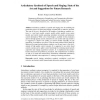Free Online Productivity Tools
i2Speak
i2Symbol
i2OCR
iTex2Img
iWeb2Print
iWeb2Shot
i2Type
iPdf2Split
iPdf2Merge
i2Bopomofo
i2Arabic
i2Style
i2Image
i2PDF
iLatex2Rtf
Sci2ools
COST
2008
Springer
2008
Springer
Articulatory Synthesis of Speech and Singing: State of the Art and Suggestions for Future Research
Articulatory synthesis of speech and singing aims for modeling the production process of speech and singing as human-like or natural as possible. The state of the art is described for all modules of articulatory synthesis systems, i.e. vocal tract models, acoustic models, glottis models, noise source models, and control models generating articulator movements and phonatory control information. While a lot of knowledge is available for the production and for the high quality acoustic realization of static spoken and sung sounds it is suggested to improve the quality of control models especially for the generation of articulatory movements. Thus the main problem which should be addressed for improving articulatory synthesis over the next years is the development of high quality control concepts. It is suggested to use action based control concepts and to gather control knowledge by imitating natural speech acquisition and singing acquisition scenarios. It is emphasized that teacherlearne...
| Added | 18 Oct 2010 |
| Updated | 18 Oct 2010 |
| Type | Conference |
| Year | 2008 |
| Where | COST |
| Authors | Bernd J. Kröger, Peter Birkholz |
Comments (0)

